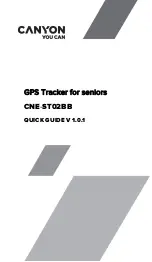
Applied Ballistics Glossary of Terms
NOTE: The Applied Ballistics feature is available only on the Foretrex 701 device.
Shooting Solution Fields
DOF: The direction of fire, with north at 0 degrees and east at 90 degrees. Input field.
TIP: You can use the compass to set this value by pointing the top of the device toward the direction of
fire. The current compass value appears in the DOF field. You can select ENTER to use this value. You can
manually enter a value by selecting or
.
NOTE: The DOF is used only for calculating the Coriolis effect. If you are shooting at a target less than 1,000
yards away, this input field is optional.
ELEVATION: The vertical portion of the aiming solution, displayed in milliradians (mil) or minute of angle (MOA).
RNG: The distance to the target, displayed in yards or meters. Input field.
W 1/2: The wind speed 1, wind speed 2, and wind direction. For example, if the wind direction is DIR 9:00, the
wind is blowing left to right as viewed by the shooter. Input field.
NOTE: The wind speed 2 field is optional. Using both wind speed 1 and wind speed 2 is not an effective way
to account for different wind speeds at different distances between you and the target. Using these fields
is a way to bracket (isolate) the wind values and calculate minimum and maximum windage values for the
solution.
WINDAGE 1: The horizontal portion of the aiming solution based on the wind speed 1 and wind direction,
displayed in milliradians (mil) or minute of angle (MOA).
WINDAGE 2: The horizontal portion of the aiming solution based on the wind speed 2 and wind direction,
displayed in milliradians (mil) or minute of angle (MOA).
Additional Output Fields
AERO JUMP: The amount of the elevation solution attributed to aerodynamic jump. Aerodynamic jump is the
vertical deflection of the bullet due to a crosswind. If there is no crosswind component or wind value, this
value is zero.
COS INCL: The cosine of the inclination angle to the target.
DROP: The total drop the bullet experiences along its flight path, displayed in inches.
H COR EFFECT: The horizontal Coriolis effect. The horizontal Coriolis effect is the amount of the windage
solution attributed to the Coriolis effect. This is always calculated by the device, although the impact may be
minimal if you are not shooting at extended range.
LEAD: The horizontal correction needed to hit a target moving left or right at a given speed.
TIP: When you enter the speed of your target, the device factors the necessary windage required into the total
windage value on the Applied Ballistics page.
MAX ORD: The maximum ordinance. The maximum ordinance is the maximum height above the axis of the
barrel that a bullet will reach along its flight path.
MAX ORD RNG: The range at which the bullet will reach its maximum ordinance.
REM ENERGY: The remaining energy of the bullet at target impact, displayed in foot-pounds of force (ft. lbf) or
joules (J).
SPIN DRIFT: The amount of the windage solution attributed to the spin drift (gyroscopic drift). For example, in
the northern hemisphere, a bullet shot out of a right-hand twist barrel will always deflect slightly to the right
as it travels.
TOF: The time of flight, which indicates the time required for a bullet to reach its target at a given range.
V COR EFFECT: The vertical Coriolis effect. The vertical Coriolis effect is the amount of the elevation solution
attributed to the Coriolis effect. This is always calculated by the device, although the impact may be minimal
if you are not shooting at extended range.
VEL MACH: The estimated velocity of the bullet when it impacts the target, displayed as a factor of mach speed.
VELOCITY: The estimated velocity of the bullet when it impacts the target.
Environment Fields
Appendix
23




































